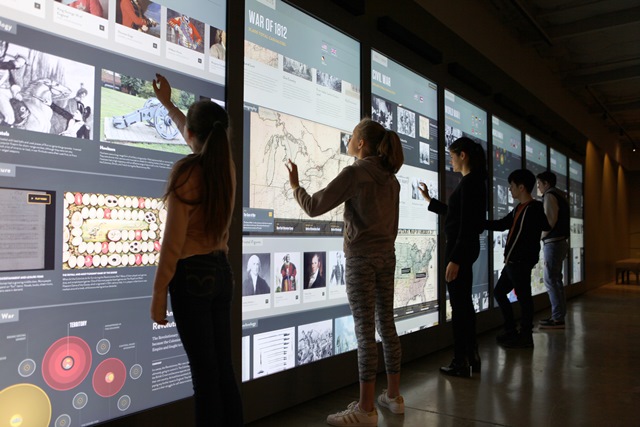SU's Cashman Helps Create 'Why War?' Exhibit
Tuesday April 18, 2017

SALISBURY, MD---GeekWire.com calls “Why War?” — the new exhibit at the Flying Heritage & Combat Armor Museum in Everett, WA — “groundbreaking.”
Believed to be the first permanent exhibit in the world dedicated to the causes of war, the addition has earned critical acclaim for the museum, owned by Microsoft co-founder Paul G. Allen, since opening in March. It may not have been possible, however, without the help of Dr. Greg Cashman, Salisbury University political science professor emeritus.
With Dr. Leonard Robinson, also of SU’s Political Science Department, Cashman coauthored the book An Introduction to the Causes of War: Patterns of Interstate Conflict from World War I to Iraq in 2007. Dr. Adrian Hunt, the museum’s executive director, purchased that book, along with several others on the causes of war, after being charged by Allen to consider an exhibit on the subject.
 |
| Greg Cashman |
In 2014, shortly after Cashman’s retirement from SU following more than three decades in the classroom, Hunt reached out to explore the idea for the exhibit, noting that the approach taken in his and Robinson’s book was a good fit for the museum’s plans. He asked if the professor would consider serving as a consultant for the project.
Cashman was intrigued. After an initial meeting, however, it seemed like the idea might not get off the ground.
“How do you do an exhibit on a very conceptual theme – the causes of war – in a concrete museum space filled with artifacts?” he said. “How do you get complex ideas across without boring people with a lot of text that may or may not mesh with the objects (mostly airplanes) in front of them?”
Hunt and his associates spent months considering those questions. In 2016, he contacted Cashman with a new idea: touchscreens.
Using this technology, visitors may delve as deeply as they desire into the causes of nine wars in which the U.S. was involved, from the Revolutionary War to the Persian Gulf War of the early 1990s. (Fittingly for a collection owned by a co-founder of one of the world’s largest technology companies, each eight side-by-side screen measures approximately 4 feet by 6.5 feet — believed to be the largest museum touchscreens currently in use.)
“You have to consider the causes of war the same way a physician considers the causes of cancer,” said Cashman. “You look at the risk factors.”
Based on research conducted for An Introduction to the Causes of War and his 1993 book, What Causes War? An Introduction to Theories of International Conflict (a second edition was released in 2014), Cashman showed how international events and world leaders played key roles in causing each of the nine examples. (The screens also allow users to explore the zeitgeist of each era, including technological advances and popular culture.)
Determining those risk factors was easy in comparison to the biggest challenge Cashman faced: making such complex concepts understandable for school children, who comprise much of the museum’s visitor base, while still keeping the content compelling for the military veterans and specialists who also frequent the collection.
Hunt asked Cashman to write the copy for the modules for a sixth-grade reading level. The text was then edited by a consulting team contracted by the museum and resubmitted to Cashman for approval. Hunt and Allen were pleased with the final results — and so were the museum’s guests.
“The exhibit has been amazingly popular with visitors of all ages, and many teachers have already promised to bring their classes,” said Hunt. “Dr. Cashman was invaluable to this project. A major theme of the exhibit is his concept of risk factors for war, and he was intimately involved in the whole project. From school kids to history buffs, everyone has been totally enthralled and engaged in this amazing exhibit.”
The addition is featured prominently on the collection’s website, complete with a curricula guide to help educators teach about the causes of war.
The Flying Heritage & Combat Armor Museum began in 1998, as Allen set out to acquire, restore and preserve U.S. and international military aircraft, and later vehicles, from the World War II and Cold War eras. The collection moved to its current location, at Snohomish County Airport’s Paine Field, in 2008. The site is also home to other aviation attractions, including the Future of Flight Aviation Center and Boeing Factory Tour.
Today, the museum is housed in two hangars, which comprise about 75,000 square feet, with plans to expand to a third. A portion of one of the hangars was expanded and renovated to accommodate “Why War?” which is planned as an eight- to 10-year exhibit. In addition to the screens, the display features restored and replica historical artifacts, including recreations of the first atomic bombs, infamously nicknamed “Little Boy” and “Fat Man,” credited with ending World War II.
Cashman is pleased that, following his teaching career, his work is still being used to educate children and others about the causes of war. (This includes his two books, which remain required reading for students studying political science at colleges and universities nationwide.) However, he is not necessarily looking for a second career as a museum consultant.
“I’m planning to enjoy my retirement,” he said.
His wife, Linda Cashman, former SU institutional research director, also is looking forward to settling down following a project closer to Salisbury. After working at Chesapeake College in Wye Mills, MD, she spent several years as a consultant for the Dorchester County Tourism Office, supporting efforts to restore county historical sites. Her latest initiatives were connected to the creation of the new Harriet Tubman Underground Railroad National Historical Park in Church Creek, MD.
For more information about the exhibit and the Flying Heritage & Combat Armor Museum, visit www.flyingheritage.com.
For more information about Salisbury University call 410-543-6030 or visit the SU website at www.salisbury.edu.
